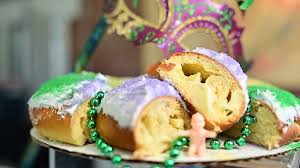
Mardi Gras
Mardi Gras is the beginning of the Carnival season starting on January 6th and continuing through February 21st. Best known for its mudbug festivals, crawfish boils, brass bands, costumes, parties and of course the Krewe floats and King cakes!
Most people think that it started in New Orleans but it in fact started in the early 17th century in Rome for early Spring and fertility.
In the U.S. in 1703 was the first Mardi Gras in Mobile, Alabama. New Orleans was established in 1718 and 1703. It was openly celebrated but not the way we see it today with the parades and all. It started with the elegant balls. By 1803 there were masked carriages with torch lights to lead the way. In 1856 the first Krewe (Comus) with dazzling floats and masked balls appeared.
In 1870 the second Krewe (Twelfth Night Revelers) was formed and did the first “throws” (throwing of beads and such). Newspapers began announcing events and prints of the of the floats after they were in the parades.
In 1872 a group of businessmen invented ‘King of the Carnival’ and honored Russian Grand Duke Alexis. Grand Duke Alexis handed out beads with the colors of his home in purple, green and gold. These colors came to symbolize the festivities meaning: purple for justice, green for faith, and gold for power. Because of the Dukes fondness for the tune, it was in this year that the theme song “If Ever I Cease to Love” became the anthem.
The Krewes were formed in secret and the members are anonymous. Most of the krewes today are formed from private social clubs with very restrictive membership policies and are funded by the members. New Orleanians call it “The Greatest Free Show on Earth!” Let the good times roll, or Laissez les bons temps rouler! (Which, is a Cajun-French expression not used in France.)
The King Cake
In Roman times bakers would make a King Cake and put a fava bean, pea, or coin inside and whoever got it would be considered King for a Day and have good luck for the year.
In the late 1930’s, Owner Donald Entringer, of McKenzie’s Bakery met a traveling salesman who had a supply of babies for cake decorations. Donald had wanted to do a little something different and so began the addition of the King Cake baby.
There are many traditions with this cake. Everything about it has some type of tradition. A few of these are: If you get the baby then you host next year's party or for some you bring the cake to next year's celebration. Some put doubloons of each color so the receiver will gain that energy for the coming year.
This is a flaky, twisted, cinnamon cake shaped in an oval with a creamy icing and sprinkled with three different colored sugars of purple, green, and gold.
In 1985, because of unemployment from the collapse of the oil industry, many wanted to keep up the tradition of Mardi Gras and would order the cake. Same thing when Katrina hit in 2005, displaced residents increased sales because they introduced the cake and traditions all over the U.S. The bakeries also contributed to the rebuilding of New Orleans and enabled New Orleans to be able to celebrate Mardi Gras and the King Cake traditions.